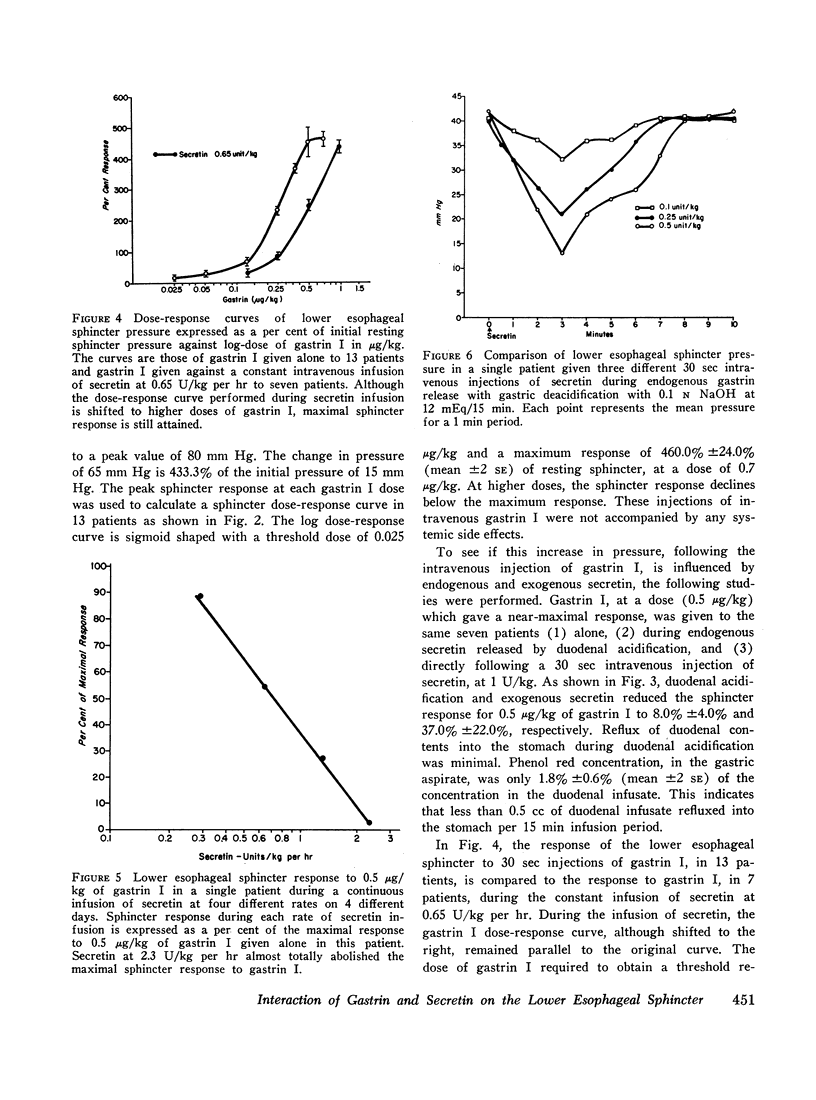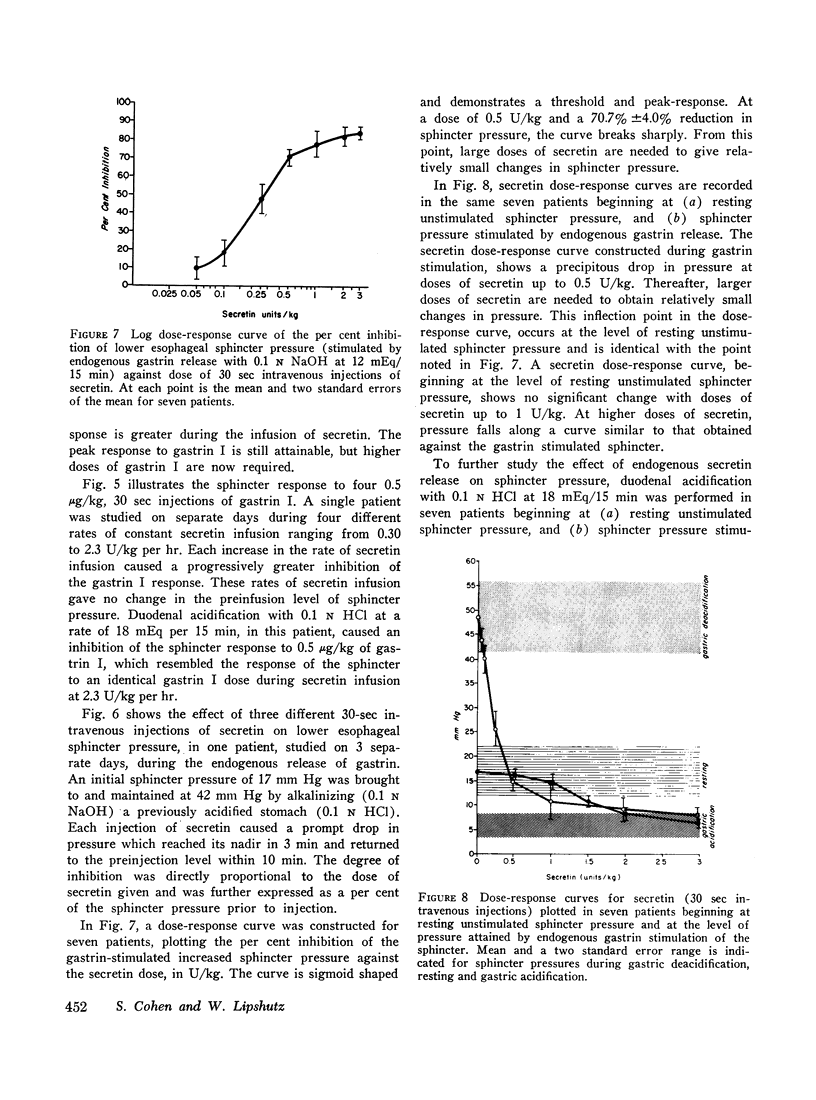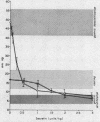Abstract
The interaction of gastrin and secretin, in the regulation of human lower esophageal sphincter competence, was studied in 54 normal subjects. A dose-response curve, for the lower esophageal sphincter, was constructed from the rapid intravenous injections of synthetic gastrin I (amino acid sequence 2-17). This curve was sigmoid shaped and showed a peak response that was 460.0 ±24.0% (mean ±2 SE) of the initial sphincter pressure, at a dose of 0.7 μg/kg of gastrin I. Secretin, either endogenously released by duodenal acidification, or exogenously administered as a single intravenous injection, markedly reduced the peak response of the sphincter to gastrin I. To ascertain the character of this inhibition, a gastrin I dose-response curve was obtained during a continuous intravenous secretin infusion. This curve showed a parallel shift to the right, with the maximal sphincter response to gastrin I still attainable at higher doses. A sphincter, endogenously stimulated by gastrin, showed a dose-related reduction in pressure with rapid intravenous injections of secretin. At the level of resting sphincter pressure, response to secretin diminished, and larger doses were required for comparable reduction in pressure. These studies indicate; (a) Secretin interacts with gastrin in the physiological regulation of human lower esophageal sphincter competence; (b) Secretin is a sensitive inhibitor to gastrin stimulation of the lower esophageal sphincter; (c) This inhibitory effect of secretin is competitive in character.
Full text
PDF





Images in this article
Selected References
These references are in PubMed. This may not be the complete list of references from this article.
- Castell D. O., Harris L. D. Hormonal control of gastroesophageal-sphincter strength. N Engl J Med. 1970 Apr 16;282(16):886–889. doi: 10.1056/NEJM197004162821602. [DOI] [PubMed] [Google Scholar]
- Cohen S., Harris L. D. Lower esophageal sphincter pressure as an index of lower esophageal sphincter strength. Gastroenterology. 1970 Feb;58(2):157–162. [PubMed] [Google Scholar]
- Emás S., Grossman M. I. Difference in responses between dogs and cats to large doses of gastrin on gastric secretion. Gut. 1967 Jun;8(3):267–275. doi: 10.1136/gut.8.3.267. [DOI] [PMC free article] [PubMed] [Google Scholar]
- Giles G. R., Mason M. C., Humphries C., Clark C. G. Action of gastrin on the lower oesophageal sphincter in man. Gut. 1969 Sep;10(9):730–734. doi: 10.1136/gut.10.9.730. [DOI] [PMC free article] [PubMed] [Google Scholar]
- Hansky J., Cain M. D. Radioimmunoassay of gastrin in human serum. Lancet. 1969 Dec 27;2(7635):1388–1390. doi: 10.1016/s0140-6736(69)90933-7. [DOI] [PubMed] [Google Scholar]
- Isenberg J. I., Grossman M. I. Effect of gastrin and SC 15396 on gastric motility in dogs. Gastroenterology. 1969 Mar;56(3):450–455. [PubMed] [Google Scholar]
- Ismail-Beigi F., Horton P. F., Pope C. E., 2nd Histological consequences of gastroesophageal reflux in man. Gastroenterology. 1970 Feb;58(2):163–174. [PubMed] [Google Scholar]
- Johnson L. R., Grossman M. I. Analysis of inhibition of acid secretion by cholecystokinin in dogs. Am J Physiol. 1970 Feb;218(2):550–554. doi: 10.1152/ajplegacy.1970.218.2.550. [DOI] [PubMed] [Google Scholar]
- Johnson L. R., Grossman M. I. Characteristics of inhibition of gastric secretion by secretin. Am J Physiol. 1969 Nov;217(5):1401–1404. doi: 10.1152/ajplegacy.1969.217.5.1401. [DOI] [PubMed] [Google Scholar]
- Johnson L. R., Grossman M. I. Secretin: the enterogastrone released by acid in the duodenum. Am J Physiol. 1968 Oct;215(4):885–888. doi: 10.1152/ajplegacy.1968.215.4.885. [DOI] [PubMed] [Google Scholar]
- Makhlouf G. M., McManus J. P., Knill J. R. Quantitative aspects of synergism and inhibition of gastric acid secretion. Gastroenterology. 1968 Apr;54(4):532–537. [PubMed] [Google Scholar]
- Nakajima S., Magee D. F. Influences of duodenal acidification on acid and pepsin secretion of the stomach in dogs. Am J Physiol. 1970 Feb;218(2):545–549. doi: 10.1152/ajplegacy.1970.218.2.545. [DOI] [PubMed] [Google Scholar]
- Nakajima S., Nakamura M., Magee D. F. Effect of secretin on gastric acid and pepsin secretion in response to various stimuli. Am J Physiol. 1969 Jan;216(1):87–91. doi: 10.1152/ajplegacy.1969.216.1.87. [DOI] [PubMed] [Google Scholar]
- Pope C. E., 2nd A dynamic test of sphincter strength: its application to the lower esophageal sphincter. Gastroenterology. 1967 May;52(5):779–786. [PubMed] [Google Scholar]
- Sugawara K., Isaza J., Curt J., Woodward E. R. Effect of secretin and cholecystokinin on gastric motility. Am J Physiol. 1969 Dec;217(6):1633–1638. doi: 10.1152/ajplegacy.1969.217.6.1633. [DOI] [PubMed] [Google Scholar]
- Tumpson D. B., Johnson L. R. Effect of secretin and cholecystokinin on the response of the gastric fistula rat to pentagastrin. Proc Soc Exp Biol Med. 1969 May;131(1):186–188. doi: 10.3181/00379727-131-33835. [DOI] [PubMed] [Google Scholar]
- Vagne M., Stening G. F., Brooks F. P., Grossman M. I. Synthetic secretin: comparison with natural secretin for potency and spectrum of physiological actions. Gastroenterology. 1968 Aug;55(2):260–267. [PubMed] [Google Scholar]
- WORMSLEY K. G., GROSSMAN M. I. INHIBITION OF GASTRIC ACID SECRETION BY SECRETIN AND BY ENDOGENOUS ACID IN THE DUODENUM. Gastroenterology. 1964 Jul;47:72–81. [PubMed] [Google Scholar]
- Winans C. S., Harris L. D. Quantitation of lower esophageal sphincter competence. Gastroenterology. 1967 May;52(5):773–778. [PubMed] [Google Scholar]



